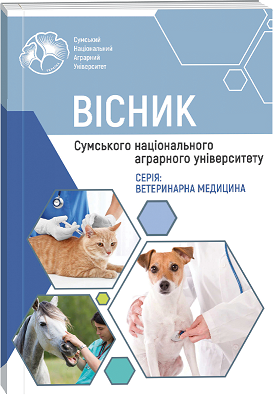АКТУАЛЬНІСТЬ ВИЗНАЧЕННЯ МАРКЕРА АЛЕРГІЇ СПЕЦИФІЧНОГО IG E В ДІАГНОСТИЦІ АТОПЧНОГО ДЕРМАТИТУ У СОБАК
Анотація
У собак з атопічним дерматитом внутрішньошкірне тестування (IDT) або алерген-специфічний серологічний тест IgE регулярно використовується для ідентифікації причинних алергенів. Потім ці алергени можна використовувати для алерген-специфічної імунотерапії та лікування алергії. На клінічну значущість цього тестування впливає джерело алергену, а інші біомаркери, які більше пов’язані з конкретними алергенами, ще потрібно визначити. Метою дослідження було дослідження собак п’яти порід на встановлення діагнозу – атопічний дерматит та визначення маркера алергії специфічного IgE. Дослідження проведені в умовах приватної ветеринарної клініки. Діагноз нозологічної форми ураження шкіри встановлювали за результатами збору анамнезу, клінічного прояву захворювання. Додатково проводили лабораторні дослідження крові хворих собак. Дослідженнями було встановлено, що алергічний дерматит частіше діагностується у порід Шарпей, Дог, Пекінес та Чау-чау. Статевої залежності випадків дерматиту не було доведено. Атопічний дерматит діагностовано у самців та самок віком 5-8 років, що становило майже 30 %. У породи Пекінес, та породи Дог у трьох самців і однієї самки, встановлено атопічний дерматит у 20 % відповідно. Серед відібраних п’яти зразків крові рівень маркера алергії специфічного IgE виявляли пилового кліща Dermatophagoides farinae у трьох тварин, до цвільового гриба Malassezia виявляли у зразках 3 і 4 на рівні першого класу, до пилку амброзії (ragweed) у трьох зразках, Ig E до бліх (flea) було у чотирьох зразках. До амбарного кліща Tyrophagus putrescentiae маркер алергії виявлявся лише в двох зразках. Дослідженнями доведений факт виникнення атопічного дерматиту пов’язаного з порушенням цілісності шкірного покриву. Маркери (Ig E) були відсутні до пилку берези, вільхи, ліщини (birch, alder, hazel), до пилку платана, верби, тополі (platane, willow, poplar), до пилку паритарії (parietaria), до суміші 6 трав (дактиліс, лугова тирса, звичайна лугова трава, англійський райграс, тимофіївка, оксамитова трава), до пилку кропиви (stinging nettle), до пилку білої лободи (lambs quarter), до пилку подорожника (plantain), до пилку полину (mugwort), до пилку щавлю (sorrel). Перспективою подальших досліджень у цьому напрямку є розробка препаратів, здатних відновити шкірний бар’єр і підвищити природний захист від патогенних організмів.
Посилання
2. Botoni, L. S., Torres, S. M. F., Koch, S. N., Heinemann, M. B., & Costa-Val, A. P. (2019). Comparison of demographic data, disease severity and response to treatment, between dogs with atopic dermatitis and atopic-like dermatitis: a retrospective study. Veterinary dermatology, 30(1), 10–e4. https://doi.org/10.1111/vde.12708
3. Carmona-Gil, A. M., Sánchez, J., & Maldonado-Estrada, J. (2019). Evaluation of Skin Prick-Test Reactions for Allergic Sensitization in Dogs With Clinical Symptoms Compatible With Atopic Dermatitis. A Pilot Study. Frontiers in veterinary science, 6, 448. https://doi.org/10.3389/fvets.2019.00448
4. Di Tommaso, M., Luciani, A., Crisi, P. E., Beschi, M., Rosi, P., Rocconi, F., & Miglio, A. (2021). Detection of Serum Allergen-Specific IgE in Atopic Dogs Tested in Northern Italy: Preliminary Study. Animals : an open access journal from MDPI, 11(2), 358. https://doi.org/10.3390/ani11020358
5. Gedon, N. K. Y., & Mueller, R. S. (2018). Atopic dermatitis in cats and dogs: a difficult disease for animals and owners. Clinical and translational allergy, 8, 41. https://doi.org/10.1186/s13601-018-0228-5
6. Khantavee, N., Chanthick, C., Tungtrongchitr, A., Techakriengkrai, N., Suradhat, S., Sookrung, N., Roytrakul, S., & Prapasarakul, N. (2021). Immunoglobulin G1 subclass responses can be used to detect specific allergy to the house dust mites Dermatophagoides farinae and Dermatophagoides pteronyssinus in atopic dogs. BMC veterinary research, 17(1), 71. https://doi.org/10.1186/s12917-021-02768-2
7. Little, P. R., King, V. L., Davis, K. R., Cosgrove, S. B., & Stegemann, M. R. (2015). A blinded, randomized clinical trial comparing the efficacy and safety of oclacitinib and ciclosporin for the control of atopic dermatitis in client-owned dogs. Veterinary dermatology, 26(1), 23–e8. https://doi.org/10.1111/vde.12186
8. Loeffler, A., & Lloyd, D. H. (2018). What has changed in canine pyoderma? A narrative review. Veterinary journal (London, England : 1997), 235, 73–82. https://doi.org/10.1016/j.tvjl.2018.04.002
9. Marsella R. (2021). Atopic Dermatitis in Domestic Animals: What Our Current Understanding Is and How This Applies to Clinical Practice. Veterinary sciences, 8(7), 124. https://doi.org/10.3390/vetsci8070124
10. Marsella, R., Segarra, S., Ahrens, K., Alonso, C., & Ferrer, L. (2020). Topical treatment with SPHINGOLIPIDS and GLYCOSAMINOGLYCANS for canine atopic dermatitis. BMC veterinary research, 16(1), 92. https://doi.org/10.1186/ s12917-020-02306-6
11. Mineshige , T., Kamiie, J., Sugahara, G., & Shirota, K. (2018). A study on periostin involvement in the pathophysiology of canine atopic skin. The Journal of veterinary medical science, 80(1), 103–111. https://doi.org/10.1292/jvms.17-0453
12. Mineshige, T., Kamiie, J., Sugahara, G., Yasuno, K., Aihara, N., Kawarai, S., Yamagishi, K., Shirota, M., & Shirota, K. (2015). Expression of Periostin in Normal, Atopic, and Nonatopic Chronically Inflamed Canine Skin. Veterinary pathology, 52(6), 1118–1126. https://doi.org/10.1177/0300985815574007
13. Moya, R., Carnés, J., Sinovas, N., Ramió, L., Brazis, P., & Puigdemont, A. (2016). Immunoproteomic characterization of a Dermatophagoides farinae extract used in the treatment of canine atopic dermatitis. Veterinary immunology and immunopathology, 180, 1–8. https://doi.org/10.1016/j.vetimm.2016.08.004
14. Olivry, T., Mayhew, D., Paps, J. S., Linder, K. E., Peredo, C., Rajpal, D., Hofland, H., & Cote-Sierra, J. (2016). Early Activation of Th2/Th22 Inflammatory and Pruritogenic Pathways in Acute Canine Atopic Dermatitis Skin Lesions. The Journal of investigative dermatology, 136(10), 1961–1969. https://doi.org/10.1016/j.jid.2016.05.117
15. Piccione, M. L., & DeBoer, D. J. (2019). Serum IgE against cross-reactive carbohydrate determinants (CCD) in healthy and atopic dogs. Veterinary dermatology, 30(6), 507–e153. https://doi.org/10.1111/vde.12799
16. Pucheu-Haston, C. M., Bizikova, P., Eisenschenk, M. N., Santoro, D., Nuttall, T., & Marsella, R. (2015). Review: The role of antibodies, autoantigens and food allergens in canine atopic dermatitis. Veterinary dermatology, 26(2), 115–e30. https://doi.org/10.1111/vde.12201
17. Santoro , D., Marsella, R., Pucheu-Haston, C. M., Eisenschenk, M. N., Nuttall, T., & Bizikova, P. (2015). Review: Pathogenesis of canine atopic dermatitis: skin barrier and host-micro-organism interaction. Veterinary dermatology, 26(2), 84–e25. https://doi.org/10.1111/vde.12197
18. Saridomichelakis, M. N., & Olivry, T. (2016). An update on the treatment of canine atopic dermatitis. Veterinary journal (London, England : 1997), 207, 29–37. https://doi.org/10.1016/j.tvjl.2015.09.016
19. Stotska, O., Shkromada, O., & Stockiy, A. (2021). Biochemical status of blood of dogs with atopic dermatitis in the conditions of private veterinary clinic “Alfa vet” m. Konotop. Technology Transfer: Innovative Solutions in Medicine, 29-31. https://doi.org/10.21303/2585-6634.2021.002128

 ISSN
ISSN  ISSN
ISSN 



